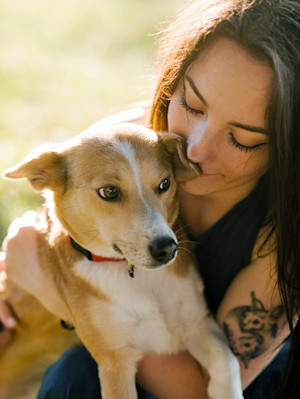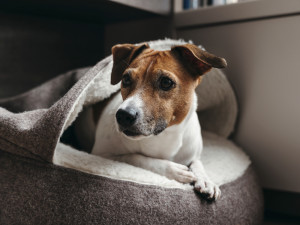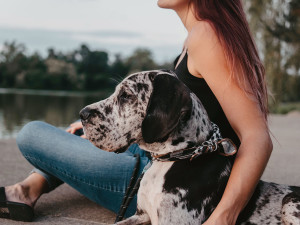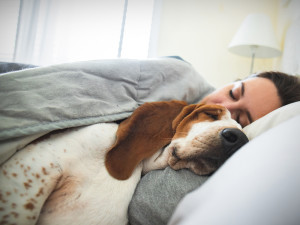Can Dogs Wake Up on the Wrong Side of the Bed?
Here’s what to do when sleepyhead is in a sour mood.

Share Article
We’ve all been there: You’ve been awake only 20 minutes, you’ve stubbed your toe, you’ve spilled your coffee, and you couldn’t smile if someone gave you a million dollars. You “woke up on the wrong side of the bed,” as the saying goes—and you’re about as grumpy as you’ve ever been.
In those moments, you’re pretty sure you’d be better off if you gave up and went back to sleep. But do our dogs experience the same thing? It seems so.
Dogs can absolutely wake up on the wrong side of the bed, says Kelly Moffatopens in a new tab, a veterinarian and veterinary behaviorist who’s the medical director at VCA Mesa Animal Hospital in Arizona.

Save on the litter with color-changing tech that helps you better care for your cat.
“Just like humans, dogs also feel a range of emotions,” she explains. “While this may not present in the same way that it does for people, it can be possible for dogs to wake up feeling cranky, such as if they haven't gotten enough sleep.”
You may wake up and be in a bad mood and be able to express that verbally, but since dogs can’t, it’s important to read the cues.
“ Being in a bad mood is such a human term,” says Tatiana Yastremskiopens in a new tab, a certified dog trainer and canine behavior consultant at St. Hubert’s Animal Welfare Centeropens in a new tab in Madison, New Jersey. “When it comes to animals, and in this case dogs, I prefer to refer to it as changes in a dog’s emotional state.”
A dog’s brain functions similarly to a human’s brain when it comes to emotions, she notes, despite the fact that their emotional range is more limited. “The hormones that govern the dog’s emotions are the same as human hormones, and therefore, dogs’ brains can go through the same or similar chemical shifts when their emotional state changes,” Yastremski explains.
In other words, they can wake up grumpyopens in a new tab just like us.
How do I know my dog’s in a bad mood?
“While dogs can certainly show signs of distress, it may not present in the same way that it does for humans,” Moffat says. “It’s important to know your dog’s specific personality traits that may point to whether your dog is feeling down.”
A pup who’s woken up feeling stressed, agitated, or just simply out-of-sorts could exhibit symptoms like pacing, whining, barking, yawning, pinning their ears back, panting, digging, tucking their tail, or simply hiding, according to Moffat.
Every dog’s an individual, so the way each one expresses a “bad mood” will be different, Yastremski says.
You should be especially concerned if you think the bad mood could be caused by pain. “If pet parents are observing something that is not characteristic of their dog, they should take note,” Yastremski explains. “For example, if one’s dog usually loves being pet or massaged, and suddenly either avoids the activity, or begins showing aggressive behaviors to prevent being pet ... the dog could be experiencing physical pain.”
What triggers a dog’s bad mood?
A bad dream, pain, a poor night’s sleep, or a multitude of things can cause a dog to wake up in a “bad mood,” in the same way that a human’s grumpy attitude can have many causes.
“A stressful experience from the previous day, such as a visit to a veterinarian, may have an impact on the dog’s mental state,” Yastremski says.
Physical pain, as well as seasonal or sudden weather changes, can also affect your dog’s emotional state. “Some dogs are very sensitive to the changes in barometric pressure and can sense an approaching stormopens in a new tab,” Yastremski notes. “While this may not necessarily result in a ‘bad mood,’ one can see their dog’s anxiety level increase.”
A bad night’s sleep or changes to a dog’s routine could also result in a grumpy pup, Moffat adds.
And Yastremski notes that good experiences can also produce emotional changes. Her lucky pup had a very busy week recently: day camps on alternating days of the week and a scent-tracking classopens in a new tab, which turned out to be very stimulating but also tiring. Later that day, when Yastremski tried to massage her paws (something her dog has enjoyed for two years), she showed her teeth and growled at her.
“By doing that, she communicated to me that she didn’t want me to touch her paws. I respected her wishes and realized that she was most likely really tired from her multiple escapades that particular week,” Yastremski says. “I now know that when my dog is tired, she wants me to leave her be.”
How can I help my dog if they wake up in a bad mood?
Moffat says that one of the most important things you can do is stick to your routine that day to “help your dog get back on track.” If you must veer from your routine — for example, if you have guests over — give your dog a safe haven where they can take some time for themselves, she says.
Tent beds or extra cozy crates can be good for letting a dog decompress as long as they can come and go as they please.
“ Pet parents should listen to their dogs and respect their wishes,” Yastremski says. “If one’s dog growls in response to being touched or pet, stop petting and give them the space they need. Allow the dog to decompress. For some dogs, this could mean going for a nice sniff-y walk opens in a new tabwhere they get to explore new scents, for other dogs this may mean gnawing on a bone or a long-lasting chew, and yet others it could be a fun game of fetch or tug with their human.”
When should you see a vet?
“If the issue remains consistent or your dog is acting out in a way that could be dangerous — such as digging under the fenceopens in a new tab and escaping — it might be a good time to check in with your veterinarian,” Moffat says. “They can help you ensure your dog's behavior isn't caused by a medical issue; for example, some dogs will act differently if they are in pain.”
Keep a record of your dog’s out-of-character behavior by jotting it down in your Notes app or filming it, and be ready to share it with your vet, Yastremski says.
“Once a medical issue is ruled out, consulting with a certified professional trainer, a behavior consultant, or a veterinary behaviorist should be your next step,” she adds. With all hands on deck, you’ll be able to get to the root of the problem. That way you and your pup can get a good night’s sleep and wake up refreshed and ready to take on the world together — or just spend the day happily snuggling on the sofa.

Marti Trgovich
Marti Trgovich is a New York–based writer whose work has appeared in the New York Times Tiny Love Stories, the New Yorker Shouts & Murmurs, and The Dodo. She is mom to a senior rescue pup named Claude.
Related articles
![Brunette girl with tattoo on shoulder hugs dog.]() opens in a new tab
opens in a new tabDo Dogs Get Grumpy? Yes, So Here’s How to Cheer Them Up
Canine grumpiness is very real and the summer heat doesn't help.
![A dog looking timid in his bed]() opens in a new tab
opens in a new tabHow to Help Thunder-Phobic Dogs
Tips for comforting your pup when the storm is too loud for your pup’s comfort.
![A woman sitting with her arm around a dog enjoying a view of water.]() opens in a new tab
opens in a new tabHow to Cure Your Dog’s Case of the Everyday Scaries
There’s nothing to fear but fear itself — and a dog who won’t stop shaking when it thunders.
![Pet parent comforting anxious dog by holding their paw]() opens in a new tab
opens in a new tabHow to Help an Anxious Dog
Easy ways to calm your pup’s nerves.
![Shiba inu dog sleeping in bed]() opens in a new tab
opens in a new tabMy Dog Sleeps All Day—Is That Normal?
Dogs need more sleep than humans. Here’s how much is healthy.
![Woman and dog sleeping together in bed]() opens in a new tab
opens in a new tabWhere Should Your Dog Sleep at Nighttime?
It’s a personal preference, but here are the pros and cons.








